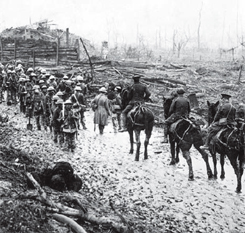About Horses in the First World War
• When the war began in 1914, the British Army possessed a mere 25,000 horses
• The War Office was immediately tasked with finding another half a million to go into battle
• As well as in the cavalry, they were needed to transport weapons and supplies and to carry the dying and wounded to hospital
• During the war, the main source of horses came from the United States and between 1914 and 1917 around 1,000 were sent by ship every day – with these ships under constant enemy attack
• In battle, horses were vulnerable to artillery and machine gun fire as well as to the harsh winter conditions on the front line
• The losses were appallingly high and mirrored the human losses in the terrible battles of the Somme and Passchendaele
• Of the one million horses sent to the Western Front by Britain, over 900,000 did not return home
• It is estimated that over eight million horses, donkeys and mules died in total in the First World War
• With the involvement of the RSPCA and the Royal Army Veterinary Corps, the care of horses during the war improved immeasurably with the creation of special veterinary hospitals by the British Army
• Due to the development of tanks and the evolution of warfare, it would be the last time the horse would be used on a mass scale in modern conflict
 Life at the front - Horses did much of the dirty work
Life at the front - Horses did much of the dirty workThe First World War
28 June 1914
The assassination of Archduke Franz Ferdinand
The assassination of the heir to the Austrian-Hungarian throne led to several complex alliances, formed over previous decades, being invoked. Within weeks the major European powers were at war both in Europe and worldwide via their colonies.
28 July 1914
The beginning of the First World War
The Austro-Hungarian alliance declared war on Serbia on 28 July 1914. In August Germany invaded Belgium and Luxembourg (with the aim of getting as quickly as possible to Paris) and opened up the notorious Western Front. Britain declared war with Germany on 4 August 1914. America stayed neutral until 6 April 1917. The First World War was played out not only across the notorious areas of Western and Eastern Europe, but across the Balkans and further afield in the Middle East and elsewhere.
1915–1918
Stalemate on the Western Front
The Western Front was the most infamous of all the fronts in the First World War. The Western Front stretched 440 miles from the North Sea in Belgium across France to the Swiss border. Despite the many offensives, the line of trenches, dug-outs and barbed wire moved little in this time. These offensives employed massive artillery bombardment and massed infantry advances. However, a combination of machine guns, barbed wire and artillery repeatedly inflicted severe casualties on the attackers and the counterattacking defenders.
Amongst the major offensives on the Western Front were:
The Battle of the Frontiers August 1914
The First Battle of the Marne September 1914
The First Battle of Ypres October – November 1914
The Second Battle of Ypres April 1915
Battle of Verdun February – December 1916
The Battle of the Somme July – November 1916
The Battle of Arras April – May 1917
The Third Battle of Ypres July – November 1917
11 November 1918
The end of the First World War
Four major empires – the German, Russian, Austro-Hungarian and Ottoman Empires – were defeated and ceased to exist. The Russian Revolution in 1917, led to the cessation of the war between Russia and Germany with a treaty in early 1918.
June 1919
The League of Nations
This international body was created in the hope of preventing another conflict. However, European nationalism particularly in Germany, the break up of empires and other economic problems led to the Second World War in 1939.
More than nine million people were killed in The First World War.
Imperial War Museum - www.iwm.org.uk